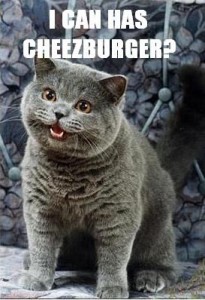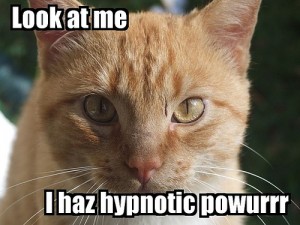I can has academia? A thesis on “lolspeak”
 Source: etd.lsu.edu
Source: etd.lsu.edu
There are some who would think that your internet privileges should be revoked should you never have run across lolcats – photos of cats, often in humorous positions, captioned in what seems like a rudimentary form of English. One of the most famous lolcats, rather overweight specimen of a cat, bears the caption “I can has cheezburger?”, which helped spawn not only a plethora of other lolcat images, but also the website icanhascheezburger.com (which has just celebrated its five-year anniversary), where people can submit their own.
lolcats are a prime example of what is known as a meme: an image or concept that spreads rapidly from user to user over the internet (also known as a “macro image”). There are many of these, and to the unfamiliar their names seem very odd indeed, for example: “socially awkward penguin”, “good guy Greg”, “nope! Chuck Testa”, and “internet husband”. Confused? Luckily there is a site that seeks to help out those dazed and confused by the huge variety of memes that have gained popularity or notoriety – knowyourmeme.com.
 However, it seems that in the 5 years since the meme first became popular online and spawned thousands of copycats (sorry), there is more to “lolspeak” than meets the eye. So much so, in fact, that Jordan Lefler, a student at the Louisiana State University, has published a 129-page thesis entitled “I can has thesis?: A linguistic analysis of lolspeak”. In the thesis she explores “lolspeak” from its very roots as an image meme, to its evolving linguistic properties. While it may seem to be a randomly warped version of English, it turns out that “lolspeak” – kind of like ebonics – is an artificial dialect in its own right, and actually has its own syntax, formulas and punctuation rules, the proof being that there is enough structure there for somebody to write an entire thesis about it.
However, it seems that in the 5 years since the meme first became popular online and spawned thousands of copycats (sorry), there is more to “lolspeak” than meets the eye. So much so, in fact, that Jordan Lefler, a student at the Louisiana State University, has published a 129-page thesis entitled “I can has thesis?: A linguistic analysis of lolspeak”. In the thesis she explores “lolspeak” from its very roots as an image meme, to its evolving linguistic properties. While it may seem to be a randomly warped version of English, it turns out that “lolspeak” – kind of like ebonics – is an artificial dialect in its own right, and actually has its own syntax, formulas and punctuation rules, the proof being that there is enough structure there for somebody to write an entire thesis about it.
You can read the entire thesis for free on the lsu.edu site.
